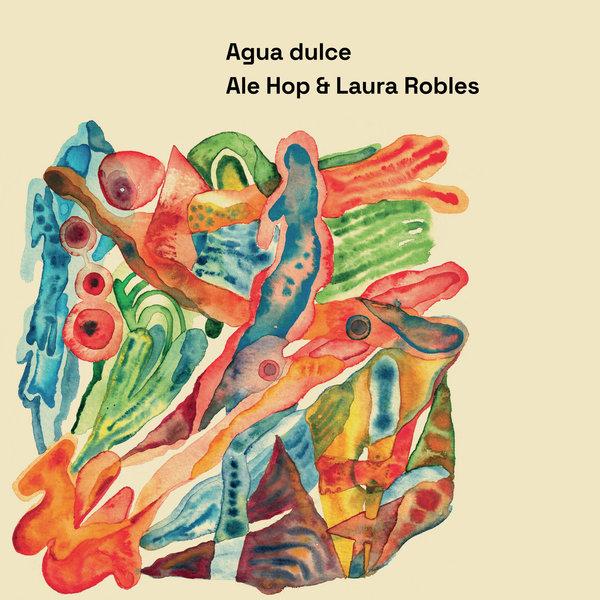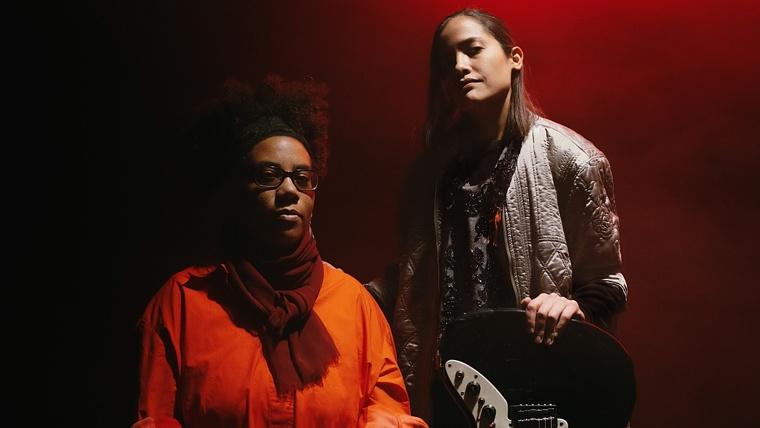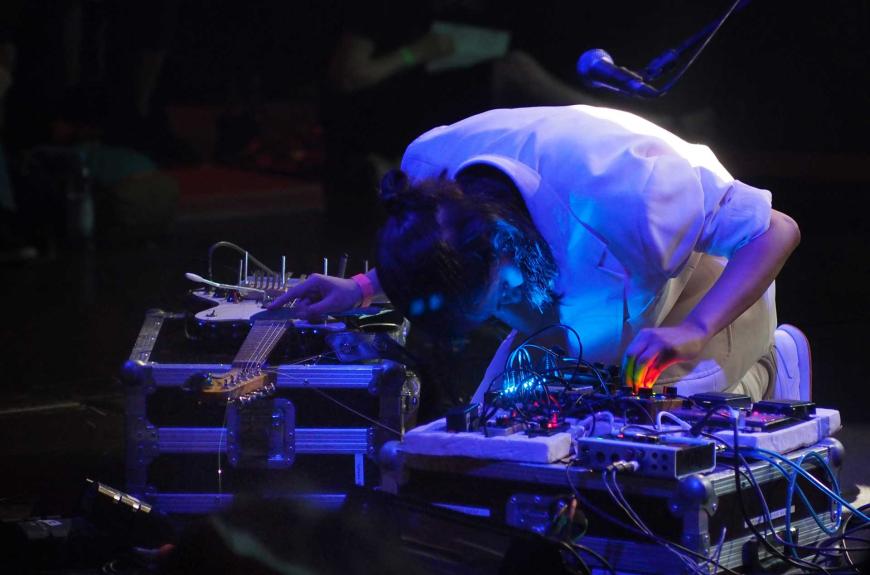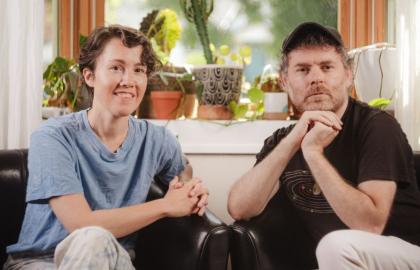Alejandra Cárdenas, better known as Ale Hop, and Laura Robles both grew up in Lima (Peru), but they only got to know each other in Berlin, where the two musicians live. It turned out to be a fruitful encounter, as their joint debut album Agua dulce from 2023 proves, which is named after the beach where they spent their youth. The traditional rhythms of their birthplace are deconstructed and electronically amplified into a high-voltage performance full of tension. Electronic modulation of the cajón, a percussion instrument that Black slaves used to make from wooden fruit boxes, lies at the heart of their work. Synthesizers and electric guitars mutate this Peruvian dance music even further into nostalgic textures.
Could you tell us a bit about the emotional process behind the inception of the album?
Ale: Laura has long been exploring Peruvian roots throughout her career. My place in the project was to find a sound constellation that can support and reinforce the position of the cajón. The idea behind it was to bring it into a contemporary language and find its spirit through sound while reflecting on and responding to its history and Laura’s experiences within traditional music, which in many ways informed our improvisation sessions, and the production, afterwards.
Laura: Although it’s been many years since I started playing the cajón in a non-traditional way, the constant criticisms and hostile comments for having stepped out of the traditional line always come to my mind. So whenever I do something new, I feel a kind of fear, a small fear I’ve grown fond of, which leads me to play much more freely. So basically, here I can apply: I play the way I want and feel.
The album has an extremely moving female presence and strength. How was the creative process of working together for this release (which I imagine was perhaps quite different from your respective solos)? How did you complement each other’s work?
Laura: Although we both come from the same city and the same district, we have totally different schools; you might even think that they are not so compatible when it comes to rehearsing, composing and even playing. But we have found a very interesting way of working. Each one has her own space to compose and propose, we have meetings with very specific themes, and then each one continues to develop each point at home, we meet again and so on.
Ale: We recorded the main elements of the record, improvising together. In our improv sessions, we spend half the time talking, exchanging experiences, and eating. What we played afterwards was very informed by this process of meeting each other.
In the album, you explore the deconstruction of traditional rhythms of the Peruvian coast and shake the ossified use of the cajón in the global music circuit. What challenges did you face for the album development? How did you deepen in the beautiful interplay between cajón and electric guitar?
Ale: Technically, I wanted to show the unique sonority of the cajón and expand it. I particularly like the attack of its sound, the way the wood vibrates, the dryness of the resonance, and the hand’s presence. I didn’t want to revisit the usual recording methods for the cajón because I was interested in capturing a range of frequencies that is perhaps different from what is typically recorded. I simply listened to Laura play one afternoon and decided on my own the microphones and their positions.
Laura plays with the so-called “cajón padre”, which she calls the “cajón madre”, which is played on both sides, so I also had to capture the spatiality of the instrument. I recorded three mics, two of them on each side, very panned for exaggerating this spatiality and very sensitive to capture the sensation of the hands touching the wood. I wanted the listener to feel a certain proximity and intimacy and a third microphone to capture the resonance box. From the beginning, I avoided trying to make it sound closer to a drum kit, that is, to enhance the sound’s lows and force the hit sound into a kick. Wood has its only unique character.
The effects we used for the cajón, be it distortion, flanger or other synthesis processes, were always oriented to highlight or exaggerate the essence of the cajón and not to hide it. On the other hand, the first time we played together, Laura told me not to try to follow her with the guitar. This mandate was something I took to heart in the musical production. I approached the production as always, having the cajón in the central position and then the electronic elements and guitars revolve around.
While producing it, I imagined that the cajón is at the bottom of a pool and all the other elements flood it at different levels, sometimes covering it completely, sometimes barely moistening it. The only track where the strategy changes is in Fuga en Alcatraz, where the cajón tries to follow the oscillator. It is interesting because it is the fugue rhythm of the Peruvian dance called Alcatraz, while the cajón is trying to play at the tempo of the oscillator giving a sensation of chasing.
The album is named after one of the most popular beaches in Lima, where you both grew up. Beaches and the sea and oceans are truly magical places. Thinking on psychogeography ideas, what was the influence or presence of Agua Dulce throughout the production of the album?
Laura: In Lima, there was an avenue called Huaylas, now renamed as Av Defensores del Morro. It is chaotic, there are thieves and a variety of smells and noises, but it is also immensely full of life and creativity of thousands of people looking to do some business. At the end of this avenue is a boardwalk (Malecón de Chorrillos district), where you can see directly to the beach, “Agua Dulce”, which is very beautiful. It is not just a small beach, you can see the infinity of the Pacific, there is no noise, it is calm, and when there is sun, you can imagine you are in some paradisiacal place. We have both grown up with that contrast reflected in our compositions.
From its birth, the cajón symbolised resistance, experimentation and transformation. What are your reflections, at a personal level, in regard to the cajón symbolism and meaning after this album? Did they evolve throughout the process?
Laura: Since I was very young, I have believed that the cajón is an instrument with which you can play almost anything you want. It is not an instrument purely and exclusively for the music of the central coast of Peru. At the same time, for reasons of respect, technique and learning, I think it is essential to learn it from tradition, to know the rhythms and, very importantly, the dance. In Agua Dulce, I have united the more modern forms with tradition, thus having much more freedom than in a choreography, for example. Evolution is a big word for me. My processes are quite slow. I will be able to think about it in some time; for now, it’s just the beginning.
What were your main inspirations during the production of the album?
Laura: During the process, I was thinking more about what Lima is like, my youth and how everything has changed being in Berlin, the different types of chaos.
What is your relationship with technology nowadays? And how do you cope with technology (screen/digital) overload?
Laura: I know how to send Emails, and occasionally, I post something on Facebook or Instagram. I have a basic computer. I like my instruments. I get exhausted when I’m looking at any screen. I also get depressed by the content. I guess if I tolerated technology more, I would have more gigs or my works would be more known, but well…I don’t like it at all. My thing is to make music.
Ale: I spent hundreds of hours on the computer producing this album. I think this kind of hyper-focused activity has always appealed to me. It’s a lonely and excruciating job, sometimes, because you want to do your best, and it entails a lot of questioning and doubting. But other technologies, for example, cell phones, seem to me to be aggressive and consuming. The amount of notifications one receives makes it very difficult to be attentive and develop what you want to do.
We thank CLOT Magazine for allowing us to use this interview. Read the original double interview here.







